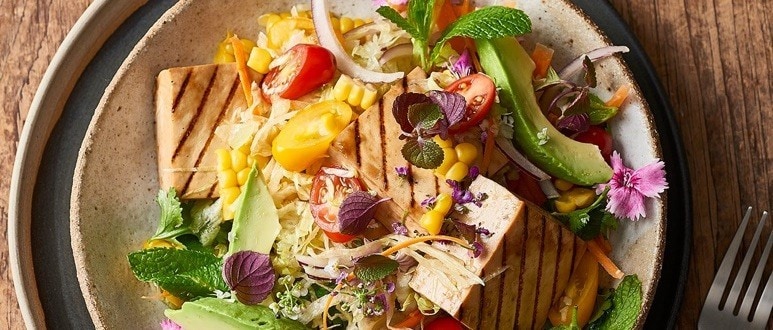As consumer preferences have shifted toward plant-based diets in recent years, diners are looking for alternative options on restaurant menus. Yet, how much do you know about plant-based meat? It’s important to be aware and to know how to integrate these plant-based proteins to cater to different groups of diners.
What are plant-based meats?
Plant-based meats are made from plants and act as an alternative to meats made from animals. This can take on many different forms, such as burger patties, nuggets, meatballs, fillets, sausages and more! While some foods use vegetables and legumes, technological advancements have made other alternatives possible. This includes the use of proteins and extracts from plants such as peas, soybeans, or wheat to make the appearance, taste, and texture as close to animal meat as possible.
In fact, there are now a variety of plants used in enhancing the taste, texture, and appearance of these plant-based meats to ensure that diners get to enjoy their foods without harming any animals in the process.
Is plant-based meat safe?
The growing trend of plant-based options means that these meat alternatives are now subject to scrutiny, often by the meat industry who is threatened by this growing market. Many consumers who are new to plant-based meat also wonder about how safe plant-based meats are to consume.
However, this meat alternative is actually far healthier than meat made from animals. In fact, many agree that eating a mix of whole and minimally processed plant-based foods will enable you to reap great health benefits.
Why should restaurants consider the switch to plant-based meat substitutes?
With the growing trend of plant-based foods, many consumers who are new to plant-based meat also wonder about how safe plant-based meats are to consume. However, this meat alternative is far healthier than meat made from animals. In fact, many agree that eating a mix of whole and minimally processed plant-based foods will enable you to reap great health benefits.
Plant-based proteins are tied to several positives for people and the planet. Swapping meat for plants may reduce saturated fat and can increase the fibre content of dishes. Science shows that vegan and vegetarian diets can reduce the risk of diabetes, certain types of cancer, obesity, and heart disease.
By switching to these plant-based meats, you’re also skipping the risk of disease that comes with animal-based meats, especially given the less-than-ideal environments that many of these animals live and die in.
Also, plants require fewer environmental resources like water and space, which can offset climate change. Finally, vegetarian proteins are food sources that animal lovers can feel good about eating.
How to introduce plant-based foods to your restaurant menu

Restaurants can boost customer satisfaction, and therefore popularity, by tweaking menus to provide more plant-based choices. In fact, many restaurants are loading their menus up with scorched cauliflower, smoked mushrooms, and salt-baked turnip wraps.
How can you satisfy your customers’ cravings while also cashing in on the latest plant-based protein trends? Here are some plant-based menu ideas to try:
- Add one or two vegan meals to your current menu
- Substitute meats in current dishes with vegan protein options
· Tofu
· Black beans
· Chickpeas
· Corn
· Tortillas (wheat, rice, and corn) - Simply go more plant-heavy and shift meats to the backseat in some or all recipes
It can be easy to take a traditional option – like a pizza or burger – and turn it into something meat-free. Pizzas can be laden with delicious roasted veggies, and burger meat can be imitated deliciously with mushrooms or black beans.
· Stir-fry Kung Po NoChicken
An Asian-inspired stir-fried chicken recipe that can be easily transformed to plant-based with The Vegetarian Butcher NoChicken Chunks
· Wok-fry Sweet & Sour NoMeatball
Excite your diners with this plant-based rendition of east meets west, easily made with The Vegetarian Butcher NoMeatballs
· Boiled Sichuan NoBeef
Appeal to your diners with various dietary requirements and palates with this plant-based Asian recipe
Not only can you attract new diners with plant-based recipes, but your current customers may also be intrigued by novel menu additions.
However, it’s not only diners that love these meat alternatives — chefs are falling in love with plant-based meats as well.
With shorter cooking times, being delivery friendly, a very “forgiving” protein to work with and more, it’s no surprise. In fact, overcooking plant-based meat isn’t often an issue, and finding that ideal “sweet spot” is also so much easier – which means more consistent-tasting meals and more satisfied diners!
Plant-based food prepping and planning: beginners' tips and tricks
Adding one or more plant-based recipes might sound intimidating at first. Fortunately, it’s not difficult to keep up with the latest plant-based trends.
Here are a few tips and tricks to make plant-based planning and prep even easier!
Take advantage of the new plant-based dish
If you’re feeling good about your current brand and theme, you might be worried about mixing things up with plant-based options.
Try this: Research some vegan or plant-based options that fit in with the rest of your menu. You can find Mexican, Italian, American and even Steakhouse options that are delicious plant-based workarounds.
When you roll out your new menu or a new dish, be sure to advertise it on social media and utilize it as a PR opportunity. Publicize it on your website and social media to build excitement and draw in an audience and start the word-of-mouth process.
Go for minimal-ingredient meals at the beginning
You can find delicious plant-based appetizers or meals with just 3-5 ingredients each. With your seasoning skills, just rice, beans, and salsa could be a truly incredible addition to the menu!
When you start with easier meals, you can batch-cook easily, and you won’t have to invest too much upfront. It will be easier to maintain food safety practices and collect the data indicating what kind of profit that will come from plant-based menu items.
Batch cook single ingredients for plant-based meals
Have those beans, quinoas, or other staples ready to substitute for other ingredients, or to throw into stir-fries, bowls, or salads.
Collect data from your customers
In addition to watching food safety practices and how many customers you’re seeing each day, watch the numbers on those new plant-based dishes. As always, track customers’ orders and ask their opinions on the new plant-based options. The earlier you can track the performance of your new dishes, the more accurate your menu design and ingredient prep will be.
If you notice that at least one or two new plant-based dishes are selling well, you may then choose to develop more options based on these dishes.
How to sell more plant-based menu items

Once you have assembled your perfect plant-based menu or recipe, how can you ensure consistent sales?
WRI studies have found which terms make plant-based foods sound more appealing, and the language that drives potential buyers away. Avoid terms like “meat-free”, “vegan”, and “vegetarian”.
One of the ways to distinguish these plant-based dishes is simply to use small icons to differentiate plant-based dishes from those with meat in them.
You can label your vegetarian and vegan dishes easily with symbols and a key.
Alternatively, you can design your dishes to be flexible to allow you to simply remove a meat item from the final dish if a diner asks for it!
There are many other ways to promote plant-based options to make them appealing to meat-eaters, such as via social media and coming up with creative names for your plant-based dishes.
Inspirational plant-based restaurants
For more guidance on how you can successfully incorporate plant-based options into your menu, check out these incredible chefs and restaurants.
1. Love Handle Burgers
Love Handle Burgers' fully vegan and classic American-style menu, vegetarians, meat-eaters, and vegans are all invited to try out their appetising burgers. The burger patties are made of plant-based meat and paired together with different sauces to create classic favourites such as the Cheeseburger, Fillet-o-Fishless, and even a Vegan “Ramli”.
2. Analogue
Analogue’s is a resto bar in the heart of the city, and many love their plant-based menu. These include jackfruit tacos with flavourful, meaty rempah-spiced filling, as well as pumpkin dumplings that boast of smooth, soft skin. Diners can pair these dishes with their favourite drinks.
3. Green Common
A one-stop plant-based eatery, marketplace, and product innovation platform, Green Common aims to empower everyone to live healthily and sustainably. Its menu includes Omni Luncheon Fries, Hainanese Trick’en Rice, Hong Kong Style French Toast and more, offering a plant-based version of typical meat dishes.
With the rise in alternative diets, it is important that your restaurant offers plant-based menu items to cater to vegetarians, vegans, and flexitarians. Tweak your menu by offering plant-based protein substitutions like tofu and black beans and create tasty plant-based dishes to leave your diners satisfied and craving more!